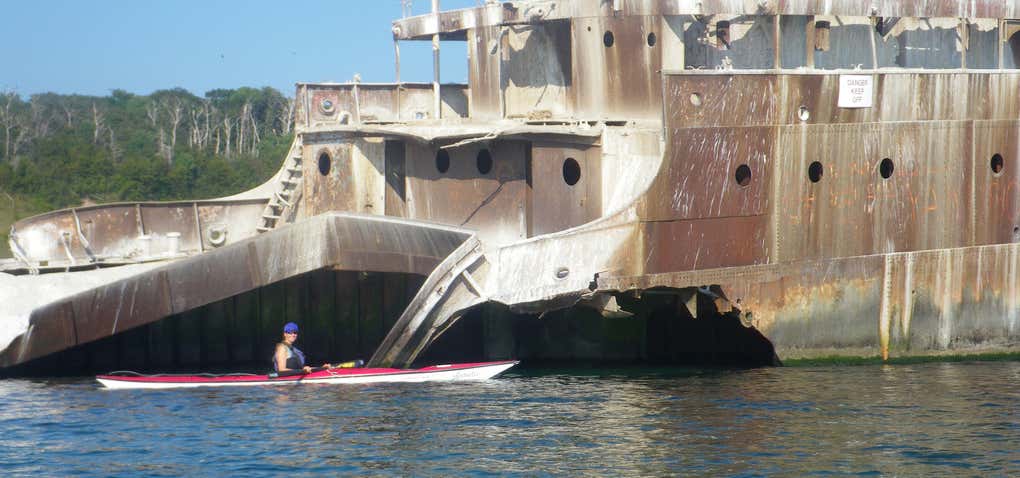“kayak to an amazing shipwreck”
Francisco Morazan was a 1,442 GRT cargo ship that was built in 1922 as Arcadia by Deutsche Werft, Hamburg, for German owners. She was sold in 1924 and renamed Elbing. She was seized by the Allies in the River Elbe, Germany in May 1945, passed to the United Kingdom's Ministry of War Transport and renamed Empire Congress. In 1946, she was allocated to the Norwegian Government and renamed Brunes. Brunes was sold into merchant service in 1947 and renamed Skuld In 1948, another sale saw her renamed Ringas. In 1958, she was sold to Liberia and renamed Los Mayas and then Francisco Morazan (for Francisco Morazán) the following year. She served until 29 November 1960 when she ran aground in Lake Michigan and was declared a total loss. Arcadia was built for Hamburg Amerikanische Packetfahrt AG, Hamburg. She was launched In June 1922. Arcadia was operated under the management of Deutsche Levant Linie AG. In 1940, Elbing was requisitioned by the Kriegsmarine for use as a coal ship in Operation Sea Lion. In March 1941 she was set on fire after being shelled by HMS Tartar during Operation Claymore and beached at Solvær, Lofoten Islands, Norway. Subsequently repaired, she saw service in Norwegian waters in 1942 and was returned to Kohlen-Import und Poseidon Schiffahrt in 1943. In 1945, her port of registry was changed to Nordenham. She was damaged after being shelled by land-based artillery and beached on Schweinesand island. In May 1945, Elbing was seized in the River Elbe. She was passed to the MoWT and renamed Empire Congress. In 1946, Empire Congress was allocated to the Norwegian government. She was renamed Brunes. On 30 June 1952, the Belgian Victory ship Mahenge collided with the French Liberty ship Granville north of Alderney, Channel Islands. Ringas rescued the 46 crew and three passengers from Mahenge, which sank. Granville was badly damaged and set on fire. She was towed into Cherbourg, France after the fire had been extinguished. In 1952, she made her first voyage to the Great Lakes, delivering a cargo of china clay to Muskegon, Michigan. In 1953, she delivered a cargo of pulpwood to Port Huron, Michigan. In 1958, Ringas was sold to a Greek owner and renamed Los Mayos. She was operated placed under the Panamanian Flag and operated under the management of Moa Navigation SA. Los Mayos visited the Great Lakes in 1958. She ran aground at Muskegon and was holed. In 1959, she was sold to C T Trapezountios, Monrovia, Liberia, and was renamed Francisco Morazan. She was operated by the West Indies Transport Company of New York and Monrovia and chartered to Interamerican Marine Operators, New York. On 21 October 1960, Francisco Morazan began what was to be her last voyage from Miami, Florida. She sailed to Montreal and Toronto, where she unloaded a cargo of phosphates. Francisco Morazan then sailed to Chicago, arriving there in mid-November. At Chicago, 1,118 tons, 10 cwt of mixed cargo was loaded, destined for Rotterdam, Netherlands and Hamburg, Germany. The cargo included aluminium, baled hair, bottle caps, canned chicken, castings, chemicals, Gilsonite, hides, lard, machinery, phosphate, scrap metal, solder dross, tinplate, and toys. Francisco Morazan departed Chicago on 28 November. Fog on Lake Michigan slowed her progress and a problem with the feed pump for the boiler required the ship to be stopped while the pump was repaired. This meant Francisco Morazan was now in a race to leave the Great Lakes before the system closed to navigation on 3 December. During the night of 28/29 November, a snowstorm greatly reduced visibility and the ship was pushed off course. At 18:35 on 29 November, Francisco Morazan ran aground on the South Manitou Island shoal, passing over the wreck of Walter L Frost on her way. She ended up just 300 yards (270 m) from the shore. The USCGC Sundew and USCGC Mesquite were sent to the aid of Francisco Morazan. The captain's pregnant wife was taken off the ship and transferred to USCGC Mackinaw. She was then airlifted to Traverse City, Michigan. The captain and 12 crew remained on board Francisco Morazan, which was not in danger of sinking. On 30 November, two people were flown out to the ship by the insurers. It was decided that Francisco Morazan was not salvageable, although it was thought possible to save her cargo. Roan Salvage of Sturgeon Bay, Wisconsin, were contracted for the recovery of the cargo. The salvage tug John Roan V and barge Maintland were sent to the scene. During the next five days, Francisco Morazan was buffeted by a storm and began to break up. All on board the ship were rescued on 4 December. Roan Salvage abandoned their intention to salvage the cargo and their ships returned to port.
The SS Francisco Morazan was a cargo hulk seized from the Germans in WWII. The allies seized her and she had a long and illustrious career until 1960 when a snowstorm threw her off course and she sunk in the Great Lakes. Today visitors can kayak out and get an up-close-and-personal view of this abandoned shipwreck beauty.
Be the first to add a review to the SS Francisco Morazan Shipwreck.
/-86.139679,45.000738,14/300x172@2x?access_token=pk.eyJ1Ijoicm9hZHRyaXBwZXJzIiwiYSI6ImNsdjQ5N2VtZDA2bW8ycW13ZHAxeGhjbjkifQ.UIccpoAxc7g3BAuK4s9vjg)
SS Francisco Morazan Shipwreck
Hours
Problem with this listing? Let us know.
Has RV parking changed? Let us know.
-
Parking
-
Pets Allowed
-
Restrooms
-
Wifi
-
Wheelchair Accessible
-
Credit Cards Accepted
Nearby Hotels
Related Trip Guides
The Great Northern is a 3,600 mile, cross-country odyssey
- 57 Places
- 69:15
- 3,565 mi
The top things to do on a Tunnel of Trees road trip
- 12 Places
- 00:51
- 31 mi
The top things to do on an I-75 road trip
- 34 Places
- 31:05
- 1,933 mi

